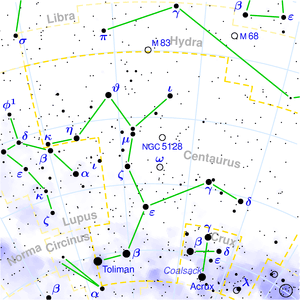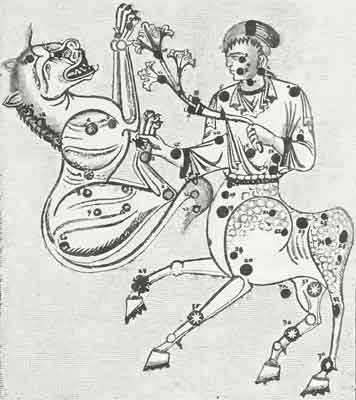
|
Centaurus ( Latin: centaur) is a bright constellation of the southern hemisphere. One of the largest constellations in the sky, Centaurus was one of the 48 constellations listed by Ptolemy, and also counts among the 88 modern constellations. Notable features Centaurus contains Proxima Centauri, red dwarf that is the nearest known star to the Sun as well as Alpha Centauri, which is a binary star to which Proxima Centauri is apparently gravitationally bound to form a triple star system. In addition to Alpha Centauri, the 4th brightest star in the sky, a second first magnitude star, β Centauri, is part of Centaurus. Notable deep sky objects Centaurus contains ω Centauri (NGC 5139) which, despite being the constellation's "omega" listing, is the brightest globular cluster and largest of its kind in the Milky Way. The nearby lenticular galaxy, radio source Centaurus A (NGC 5128) and Galaxy ESO 325-G004 is located in the area of Centaurus. History It was mentioned by Eudoxus (4th century BC) and Aratus (3rd century BC), Ptolemy catalogued thirty-seven stars in it. Mythology The constellation, when including fainter stars visible to the naked eye, resembles a stick man with the back end of a horse attached. According to Ovid (Fasti v.379), the constellation is Chiron who was a wise centaur (half-man, half-horse) known as a tutor to Jason (the leader of the Argonauts), and tutor to Heracles (a demi-god). Centaurus is sometimes associated with the constellation Sagitta, an arrow which Centaurus appears to have fired towards the constellation Aquila. As such, together with the constellation Lupus, and the fact that Centaurus is below the ecliptic, this may have formed the basis of the myth of the Erymanthian Boar, one of the Twelve Labours of Heracles. When the sun is in the sign of Virgo, it sits directly above the constellation Centaurus. The Greeks considered that the centaur Chiron, who was accidentally poisoned and died due to Heracles, while Heracles took a detour from hunting the Erymanthian Boar, was put in the sky as a mark of pity. The constellation Lupus is next after Centaurus in the sun's transit, and was to the Greeks an arbitrary hunted animal (Therion) — it became a wolf under the Romans. Centaurus appears to have fired an arrow, the constellation Sagitta, towards Aquila, the eagle that tortured Prometheus, thus appearing to release Prometheus from his torment. Centaurus is also under the ecliptic, and thus considered to be in the underworld. The centaur, after a miniature of the 14th century, "Liber der Locis Stellarum Fixarum.", Spanish Manuscript, Arsenal Library Paris References * Centaurus, by Chris Dolan * C.S. Constellations and Stars * Constellations, by Richard Dibon-Smith * Ian Ridpath and Wil Tirion (2007). Stars and Planets Guide Links
Retrieved from "http://en.wikipedia.org/"
|
|
||||||||||||||||||||||||||||||||||||||||||||||||||||

